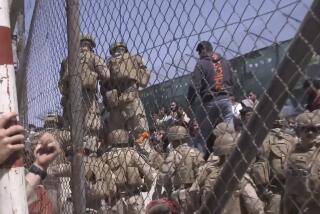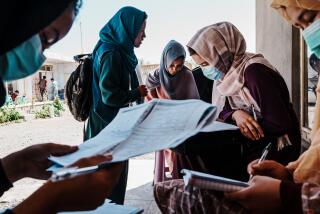U.S. Raid on Village Prompts Afghans to Demand Changes in War Strategies
- Share via
KAKARAK, Afghanistan — As the night turned to gray dawn, U.S. forces entered this remote village, proceeding at first as they would in enemy territory, searching house to house, restraining weeping relatives, speaking in brusque tones.
But then, according to villagers, they focused on the bodies. What they saw were hardly armed Taliban fighters. There were women, their bodies torn to pieces, young girls in party dresses, toddlers and infants. The soldiers realized that something had gone terribly wrong.
Of the 48 dead, all but three were women and children, according to a report compiled by Afghan government officials who visited the area.
In an episode that may prove a turning point in America’s involvement in Afghanistan, Pentagon officials have acknowledged civilian casualties, although they have neither confirmed nor denied the figures. However, now they are coming under pressure to change the way they are prosecuting the war.
“When the soldiers saw the women and children, they were sad and they told the translator, ‘We made a mistake,’ ” said villager Sahib Jan, who, like many of the victims, was attending an engagement party at the time of the raid.
Kakarak and four nearby villages in central Afghanistan were the targets of a heavily investigated and disputed bombing raid by U.S. forces on the night of June 30 and predawn hours of July 1. Although no one disagrees that a tragedy was the result, there are conflicting accounts over the circumstances of the attack: Villagers say they were firing into the air to celebrate an impending marriage; U.S. officials say there was sustained antiaircraft fire aimed at planes overhead.
Nonetheless, the soldiers’ early acknowledgment of error on the ground appears to have been repeated by U.S. officials in private conversations with Afghans up to the highest levels of government, including a telephone call from President Bush to Afghan President Hamid Karzai.
U.S. officials, including members of the military, have quietly promised to build schools, roads and hospitals and to drill wells in the district where the bombing took place, said Minister of Borders and Tribal Affairs Aref Noorzai, who led the Afghans in a joint delegation with Americans to investigate the raid.
What hangs in the balance is whether the Pentagon will agree to make the long-term changes in its military approach demanded by Afghan officials.
So far, the military has been reluctant to restrict its operations here in Oruzgan province, presumably because many people, including Afghans, believe that senior Taliban members--among them Mullah Mohammed Omar, the spiritual leader of the ousted hard-line Islamic regime--might be finding shelter here. Omar was raised less than a mile from Kakarak.
Afghan government officials, however, say that change is mandatory. And the kind of change they’re talking about would constitute a major departure from U.S. military engagements in the post-Vietnam era.
Afghans and many U.S. military experts contend that the enemy pockets that need to be rooted out require surgical strikes by ground troops. Aerial bombing, even if it is based on intelligence developed on the ground, is too risky in most situations, they say.
“They need to keep aerial bombardments to a minimum and rely more on infantry and ground forces--especially since now they are fighting against small groups of people,” said Tayyeb Jawad, chief of staff for Karzai and until recently a lawyer in San Francisco.
Pentagon officials say American forces are already limiting airstrikes.
“We are going to retain the ability to use the proper type of forces for the operational situation,” Marine Lt. Col. David Lapan, a Defense Department spokesman, said in Washington. “In this [July 1] operation we had ground troops. The air was there for support.”
Afghan officials believe that in the Kakarak incident, as in several previous bombing raids that killed civilians, the U.S. relied on intelligence from Afghan informers who were settling personal scores.
Several ministers, including Foreign Minister Abdullah, say they want the U.S. to consult closely both with local leaders installed by the new government and with the Afghan Defense Ministry before undertaking any bombing raids. But it wouldn’t be easy for the U.S. forces to conduct such consultations and retain the element of surprise they need to make the raids successful.
In a signal of the depth of the problems already caused by the July 1 raid, Kandahar Gov. Gul Agha Shirzai said Friday that he and the governors of five other ethnic Pushtun provinces in central Afghanistan, including Oruzgan, would require U.S. forces to seek their permission before launching military operations in their region.
He also announced the creation of two militias independent of the central government, one of which would work with the U.S. military. Such a development, if it comes to fruition, would be disastrous for U.S. efforts to foster a strong central government.
The crucial issue is the stability of the nascent government, according to diplomats and Afghan officials. They warn that if the U.S. continues to make bombing errors, it will lose support in the regions where it is most actively pursuing Taliban and Al Qaeda remnants--and that will play into the hands of destabilizing elements in Afghan society.
“The government is dependent on the Americans.... But at the local level it’s more complicated. There are long-standing tribal affiliations that are quite strong, and they can stir up anti-colonial feelings,” said a U.N. official in Kabul, the capital.
“It’s very important that there isn’t a chance for some other elements in Afghanistan to drive a wedge between Americans and the Afghan people by taking advantage of such incidents,” said Jawad, Karzai’s chief of staff.
Others see the situation as even more serious. “They have to change what they are doing. Otherwise, they will look like the Russians,” said a seasoned Western diplomat, noting that the last experience Afghans had with a foreign power, occupation by Soviet troops, left them profoundly suspicious of outsiders’ intentions and convinced that the country would do better without them.
The seriousness with which U.S. officials are viewing the Kakarak incident appears prompted in part by what the soldiers saw when they entered the village and by the investigative team’s interviews.
Several days after the raid, the violence of the attack was still visible. A huge vat of rice, food for the guests at the engagement party, lay overturned on the ground, flies swarming around it. Shards of shrapnel, some quite heavy, littered the area.
In the house where the women had been celebrating--men and women in rural Afghanistan observe such occasions in separate homes--a hole that looked as if it had been made by a mortar gaped in the roof. In the room below, a teakettle lay twisted and burned.
Just beyond the compound’s walls, a piece of flesh hung from the branch of a fig tree.
Around midnight on June 30, the scorching summer air had finally cooled and a group of women, children in their arms, climbed the narrow stairs to the earth-and-straw roof to enjoy the breeze and celebrate the man’s engagement.
Full from eating rice, they talked and listened to the music of a traditional drum played by men in the neighboring courtyard and to the familiar crack of Kalashnikovs being fired in honor of the groom’s coming wedding. They hardly noticed the sound of U.S. airplanes overhead. Such sweeps are routine here in central Afghanistan, where it is well known that U.S. troops are still hunting remnants of the Taliban.
Minutes later, an AC-130 gunship swept close by, firing what villagers describe as bombs that exploded at roof level, spraying lethal shrapnel. Large bullets may have been fired as well. Pentagon officials have said that the casualties were probably caused by the gunship’s weaponry rather than high-altitude bombs.
“The women were jumping from the roof,” said villager Jan, 25, who was attending the engagement festivities in the neighboring house.
Two sisters and their seven children were killed where they sat, witnesses said. Another group of women and children--14 children in all--scrambled down the stairs that led to the courtyard and were killed as they ran. Some of the bodies were blown into the neighboring gardens.
“The knees and the other halves of the bodies were 40 meters apart,” said Jan Mohammed, Oruzgan’s provincial governor, who on Karzai’s instruction drove through the night to reach the village.
Mohammed, an articulate and courtly Pushtun, has veered between sharp criticism--warning of a “jihad against Americans” if they are not more careful--and more politic comments. But his willingness to voice his anger at all suggests that the Americans are losing credibility in a part of Afghanistan where no one disputes that the U.S. forces need to be operating.
Adding to the anger is the fact that this was the second major mistake in Oruzgan this year: A U.S. raid in January left 21 Afghans loyal to Karzai dead.
The U.S. military, for security reasons, has not explained fully what precipitated the massive attack on Kakarak.
But Army Col. Roger King, the spokesman at Bagram air base north of Kabul, said several coordinated operations by U.S. forces were underway the night of the raid.
Army Maj. Gary Tallman, a U.S. spokesman for the Afghan-American investigating team visiting the region, said the attack came after antiaircraft artillery was fired from inside the walled compound where the villagers said the engagement party was being held.
Similar fire reportedly came from nearby villages that lie along the same river valley as Kakarak. U.S. forces also attacked those villages and, in one, Siasang, six people died.
The Afghan villagers say they were shooting into the air, as is traditional for celebrations such as engagement parties.
Tallman acknowledged that investigators found no wreckage of an antiaircraft gun when they visited the compound but said the site had been identified by U.S. troops on the ground and verified by global positioning satellites.
Afghan officials are clearly gratified by the seriousness of the U.S. investigation, by officials’ personal expression of distress and by the offer of reconstruction aid to the impoverished region.
“Building wells and schools and a power plant, a water plant, that is very important,” Minister Noorzai said.
If it all comes to pass, perhaps growth will come out of grief. But for the groom, Abdul Malik, 17, who lost his parents in the raid, the days ahead are dark.
His old life is gone. And it is unlikely that his fiancee will marry him now that he has no parents, villagers said.
Times staff writer John Hendren in Washington contributed to this report.
More to Read
Sign up for Essential California
The most important California stories and recommendations in your inbox every morning.
You may occasionally receive promotional content from the Los Angeles Times.













